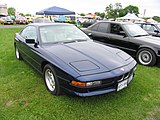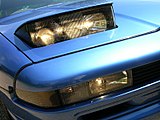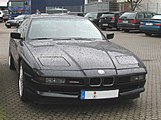BMW E31
| BMW | |
|---|---|
|
BMW 840 Ci (1995-1999)
|
|
| E31 | |
| Sales designation: | BMW 8 Series |
| Production period: | 05 / 1989-05 / 1999 |
| Class : | Upper class |
| Body versions : | Coupe |
| Engines: |
Petrol engines : 4.0-5.6 liters (210-280 kW) |
| Length: | 4780 mm |
| Width: | 1855 mm |
| Height: | 1340 mm |
| Wheelbase : | 2684 mm |
| Empty weight : | 1790-1955 kg |
| Previous model | BMW E24 |
| successor | BMW E63 |
The BMW 8 (factory intern E31 ) is an upper class - coupe of the 8-series of BMW . The 8 Series was developed under the direction of BMW chief designer Claus Luthe and was officially presented at the IAA in Frankfurt in the summer of 1989 and was produced until mid-1999.
Model history
General
The body shape comes from Klaus Kapitza, who subsequently became head of design at BMW Technik GmbH. The front section was based on that of the M1 . The 8 Series inherited the BMW 6 Series ( E24 series ), but was larger and more expensive than its predecessor. The main competitors of the E31 were the Coupé models C 126 and C 140 of the S-Class from Mercedes-Benz . The 8 Series was only available as a coupé. Prototypes of a cabriolet version were developed, but they lacked stability, see also the convertible section below (under prototypes).
The technology and engines came partly from the then current 7 Series, the E32 . Later, newer engines from the 5 Series and E38 were gradually introduced.
The E31 was the most expensive model in the BMW range until it was discontinued in May 1999. The sale of the E31 ultimately fell short of expectations, although around 5,000 sales contracts are said to have been signed before the start of series production and the buyers had to wait a full three years when production started: In ten years around 30,600 units of the 8 series were built (see the number of units in the table Technical specifications). Sales were affected by the global recession of the early 1990s, the second Gulf War, and energy price increases. In the USA in particular , BMW had expected higher sales figures, but there buyers expected more performance from such a heavy and expensive vehicle. BMW stopped selling the car in North America in 1997.
There was initially no successor to the 8 Series. It was not until the summer of 2003 that BMW added a larger, upper middle-class coupe, the BMW 6 Series E63 . However, this is based on the 5 series and was offered more cheaply than the competing CL Coupes from Mercedes-Benz .
Engines
Initially, the vehicle was only available as an 850i with the twelve-cylinder engine with 220 kW (300 hp) already known from the BMW 750i . The engines were developed for operation with regular gasoline in order to guarantee operation in the USA (due to the octane fluctuations of US fuel). Optional done here, the power transmission with a 6-speed manual gearbox or a four-speed automatic .
In the late summer of 1992 the series was expanded to include the 850CSi with a 280 kW (380 hp) twelve-cylinder engine. This was only offered with a 6-speed manual transmission and a steering rear axle , which cost the equivalent of around € 6,000 extra in the smaller twelve-cylinder units. In the same year, BMW also built 18 copies of an 830i for testing purposes. The engine used for this was the V8 M60B30 with 160 kW (218 PS) and 296 Nm also used in the E32 , E34 and E38 . None of these vehicles went on sale because the mileage did not match the vehicle class.
It was followed in the summer of 1993 by the 840i equipped with a 210 kW (286 hp) V8 . This base model was BMW's first V8 coupe since the BMW 3200 CS in the 1960s. Here, too, there was a choice between automatic and manual transmission.
In the spring of 1994 the 850Ci received a modernized twelve-cylinder with 240 kW (326 hp), which now received a five-speed automatic transmission as standard. It gradually replaced the old five-liter V12. However, both models were produced in parallel for half a year, both under the same code 850Ci. From the end of 1996 only 840Ci and 850Ci were in the program, the 850CSi was discontinued.
V-12 engine ( BMW M70 )
Prototypes (1990)
BMW M8
Only a prototype of the M8 sports model was built by M GmbH in 1990 . Other sources also speak of three vehicles, one of which was lost during test drives. The M8 was one of BMW's greatest secrets. The prototype is said to have been stored in the so-called poison cabinet , a BMW warehouse in Dingolfing - allegedly under stacks of boxes . The prototype was only shown to the public for the first time in 2010.
The engine of the M8 would have been a 6-liter V12 engine with up to 441 kW (600 hp) based on the S70 , which ultimately found its place in the McLaren F1 super sports car in a modified form . The engine of the 850CSi (which, by the way, is specified as M8 in the vehicle registration document) is based on the S70 engine, but with a displacement of 5.6 liters and only 280 kW (380 hp). The M8 prototype had no pop-up headlights : the low beam and high beam were integrated in the bumper instead of the narrow parking lights. The prototype was powered by the V12, which, thanks to a single throttle system, achieved an output of around 400 kW.
Convertible
It quickly became apparent that the E31's biggest drawback was that it did not offer a convertible version. The main rival Mercedes-Benz SL was therefore preferred to the 8 Series BMW by many customers. To retrospectively design a convertible from a stylish and large coupé like the 8 Series means a lot of stiffening work on the body, the complete development of a convertible top construction, the retuning of the chassis and powerful engines in order to be able to offer adequate driving performance. Customers were not prepared to come to terms with these compromises, and so it was another decade before a large convertible from BMW came onto the market again.
Three prototypes of the E31 were produced. The vehicle is technically based on the 850i E31 with six-speed manual gearbox introduced in 1989, was manufactured in 1990 and extensively tested by BMW and bears some details of the previously built 5-series convertible of the E34 , which also did not go into series production. The designation was adapted to the newer 8 series models from 1993 with the additional abbreviation Ci in 850Ci. “Too sluggish, not stiff, too expensive” were the reasons for the waiver for the convertible variant. Such an elaborate niche model in the luxury sector did not promise sufficient quantities and yields.
Technical specifications
| model | Engine code | Displacement | cylinder | power | Torque | 0-100 km / h | V max | construction time | Quantities |
|---|---|---|---|---|---|---|---|---|---|
| 830i | M60B30 | 2997 cc | 8th | 160 kW (218 hp) at 5800 rpm | 296 Nm at 4500 rpm | 8.3 s | 232 km / h | 04 / 1992-12 / 1992 | 18th |
| 840i | M60B40 | 3982 cm³ | 8th | 210 kW (286 hp) at 5800 rpm | 400 Nm at 4500 rpm | 7.0 s | 250 km / h | 07 / 1993-02 / 1996 | 4,728 |
| 840Ci | M62B44 | 4398 cc | 8th | 210 kW (286 hp) at 5700 rpm | 420 Nm at 3900 rpm | 6.9 s | 250 km / h | 01/1995–05/1999 | 3,075 |
| 850i | M70B50 | 4988 cc | 12 | 220 kW (300 PS) at 5200 rpm | 450 Nm at 4100 rpm | 6.8 s | 250 km / h | 05 / 1989-12 / 1992 | 20,072 |
| 850Ci | M70B50 | 4988 cc | 12 | 220 kW (300 PS) at 5200 rpm | 450 Nm at 4100 rpm | 6.8 s | 250 km / h | 01 / 1993-10 / 1994 | |
| 850Ci | M73B54 | 5379 cc | 12 | 240 kW (326 hp) at 5000 rpm | 490 Nm at 3900 rpm | 6.3 s | 250 km / h | 02 / 1994-05 / 1999 | 1,218 |
| 850CSi | S70B56 | 5576 cc | 12 | 280 kW (380 PS) at 5300 rpm | 550 Nm at 4000 rpm | 6.0 s | 250 km / h | 08/1992-11/1996 | 1,510 |
Existence in Germany
The stock of BMW E31s is listed according to the manufacturer (HSN) and type code number (TSN) in Germany according to the Federal Motor Transport Authority on the respective reference date, January 1st. Types with less than 100 vehicles are not shown. Until 2007, the inventory included the number of vehicles registered as well as the number of temporary shutdowns. Since 2008, the inventory has only included "flowing traffic" including the seasonal license plates.
| HSN / TSN | model | kW | 2005 | 2006 | 2008 | 2009 | 2010 | 2011 | 2012 | 2013 | 2014 | 2015 |
|---|---|---|---|---|---|---|---|---|---|---|---|---|
| 0005/494 | 850i, 850Ci | 220 | 3,715 | 3,439 | 2,328 | 2,185 | 2.137 | 2,078 | 2,000 | 1.929 | 1,896 | 1,907 |
| 0005/532 | 840Ci 1 | 210 | 722 | 698 | 530 | 509 | 521 | 498 | 478 | 470 | 477 | 482 |
| 0005/553 | 850Ci | 240 | 339 | 319 | 248 | 237 | 228 | 230 | 220 | 217 | 215 | 219 |
| 0005/588 | 840Ci 2 | 210 | 197 | 197 | 159 | 163 | 168 | 168 | 175 | 182 | 195 | 198 |
| 0575/309 | 850CSi | 280 | 228 | 215 | 153 | 145 | 136 | 139 | 139 | 134 | 133 | 142 |
| 7909/301 | 850CSi | 280 | 180 | 168 | 115 | 113 | 105 | 103 | 101 | 102 | 104 | |
| source | ||||||||||||
Alpina versions
The company Alpina from Buchloe developed the Alpina B12 based on the 8er . The B12 was built from 1990 to 1994 based on the 850i with a more powerful V12 engine and automatic transmission. The engine output was increased to 257 kW (350 hp), the maximum torque is 470 Nm. The compression was increased from 8.8 to 9.5; the engine displacement remained unchanged. The manually operated B12 5.7, based on the 850CSi, was also available from 1992. The V12 engine was enlarged by 70 cm 3 and the output increased by 26 kW to 306 kW (416 hp). The maximum torque of the engine is 570 Nm. Both vehicles are not limited to the 250 km / h usual at BMW, the top speed is 280 and 300 km / h respectively. 97 of the B12 5.0 and 57 of the B12 5.7 were produced.
BMW 8 Series (G15)
The name BMW 8 Series was not continued immediately. In 2017, the prototype of a successor model as the BMW Concept 8 Series Coupé was presented. BMW announced a new 8 Series in May 2017, the BMW G15 . This was introduced at the end of 2018 as a coupe and convertible and in 2019 as a grand coupe.
literature
- Oldtimer Markt 4/2009 purchase advice p.38 ff.
- Niels Hamann: BMW 8 Series - Power & Hightech. The V12 and V8 coupés of the 90s, development E31, prototypes, series models, special editions . Schneider Media UK Ltd., 2012, ISBN 978-3-7688-5799-4 (Limited luxury edition with slipcase: ISBN 978-3-7688-5798-7 ).
Web links
- The BMW 8 Series (private information site)
- Comprehensive report on the E31 including a chronicle at welt.de from July 16, 2014, accessed April 26, 2018.
Individual evidence
- ↑ a b c Report on the 8 series at auto-motor-und-sport.de/ MotorKlassik , from February 2, 2015, accessed April 23, 2018.
- ↑ Fulvio Cinti in Auto & design , issue 63 August / September 1990, Torino.
- ↑ Unrivaled and Unveiled: The M8 Prototype. In: BMW BLOG. September 13, 2010, accessed December 18, 2016 .
- ↑ GTBOARD.com: BMW M8 Prototype BMW M Garching: important step towards McLaren F1 engine. April 1, 2011, accessed December 18, 2016 .
- ↑ BMWBLOG Exclusive: Unrivaled and Unveiled - BMW M8 Prototype. In: bmwblog.com , September 13, 2010 (English).
- ↑ The number of passenger cars on January 1, 2005 by manufacturer and type with selected features. (PDF) In: Statistische Mitteilungen des Kraftfahrt-Bundesamtes, special issue 4 for series 2, January 1, 2005. Kraftfahrt-Bundesamt, May 2005, pp. 13–15 , archived from the original on March 18, 2006 ; Retrieved September 26, 2015 .
- ↑ The number of passenger cars on January 1, 2006 by manufacturer, trade name, selected features and displacement classes. (PDF) In: Statistische Mitteilungen des Kraftfahrt-Bundesamt, special issue 4 for series 2, January 1, 2006. Kraftfahrt-Bundesamt, June 2006, p. 92 , archived from the original on October 9, 2006 ; Retrieved September 26, 2015 .
- ↑ The number of passenger cars on January 1, 2008 by manufacturer, trade name, selected features and displacement classes. (PDF) In: Statistische Mitteilungen des Kraftfahrt-Bundesamt FZ 2, January 1, 2008. Kraftfahrt-Bundesamt, June 2008, pp. 98, 99 , accessed on September 26, 2015 .
- ↑ The number of passenger cars on January 1, 2009 by manufacturer, trade name, selected features and cubic capacity. (PDF) In: Statistische Mitteilungen des Kraftfahrt-Bundesamt FZ 2, January 1, 2009. Kraftfahrt-Bundesamt, July 2009, p. 104 , accessed on September 26, 2015 .
- ↑ The number of passenger cars on January 1, 2010 by manufacturer, trade name, selected features and cubic capacity. (PDF) In: Statistical Communications of the Federal Motor Transport Authority FZ 2, January 1, 2010. Federal Motor Transport Authority, July 2010, p. 104 , accessed on September 26, 2015 .
- ↑ The number of passenger cars on January 1, 2011 by manufacturer, trade name, selected features and cubic capacity. (PDF) In: Statistische Mitteilungen des Kraftfahrt-Bundesamt FZ 2, January 1, 2011. Kraftfahrt-Bundesamt, July 2011, p. 110 , accessed on September 26, 2015 .
- ↑ The number of passenger cars on January 1, 2012 by manufacturer, trade name, selected features and cubic capacity. (PDF) In: Statistische Mitteilungen des Kraftfahrt-Bundesamt FZ 2, January 1, 2012. Kraftfahrt-Bundesamt, July 2012, p. 114 , accessed on September 26, 2015 .
- ↑ Passenger car inventory on January 1, 2013 by manufacturer, trade name and selected features. (PDF) In: Statistische Mitteilungen des Kraftfahrt-Bundesamt FZ 2, January 1, 2013. Kraftfahrt-Bundesamt, July 2013, p. 26 , accessed on September 26, 2015 .
- ↑ Passenger car inventory on January 1, 2014 by manufacturer, trade name and selected features. (PDF) In: Statistische Mitteilungen des Kraftfahrt-Bundesamt FZ 2, January 1, 2014. Kraftfahrt-Bundesamt, July 2014, p. 29 , accessed on September 26, 2015 .
- ↑ Passenger car inventory on January 1, 2015 by manufacturer, trade name and selected features. (PDF) In: Statistische Mitteilungen des Kraftfahrt-Bundesamt FZ 2, January 1, 2015. Kraftfahrt-Bundesamt, July 2015, p. 29 , accessed on September 26, 2015 .
- ↑ auto-motor-und-sport.de: near-series concept car debuts at Villa d'Este (Link leads to more recent 8th article in 2018.)
| Timeline of the glass series models from 1955 to 1969 | |||||||||||||||||||||
|---|---|---|---|---|---|---|---|---|---|---|---|---|---|---|---|---|---|---|---|---|---|
| Type | independent (Hans Glas GmbH) | BMW | |||||||||||||||||||
| 1950s | 1960s | 1970s | |||||||||||||||||||
| 5 | 6th | 7th | 8th | 9 | 0 | 1 | 2 | 3 | 4th | 5 | 6th | 7th | 8th | 9 | 0 | 1 | 2 | 3 | 4th | ||
| Microcar | Goggomobil T | ||||||||||||||||||||
| Small car | Isar ("large Goggomobil") | ||||||||||||||||||||
| Lower middle class | 1004, 1204, 1304 | ||||||||||||||||||||
| Middle class | 1700 | 1800 SA, 2000 SA / 1804, 2004 [1] | |||||||||||||||||||
| Coupe | Goggomobil TS | ||||||||||||||||||||
| 1300 GT, 1700 GT | 1600 GT [2] | ||||||||||||||||||||
| 2600 V8, 3000 V8 | 3000 V8 [3] | ||||||||||||||||||||
| Vans | Goggomobil TL | ||||||||||||||||||||
|
|
|||||||||||||||||||||














